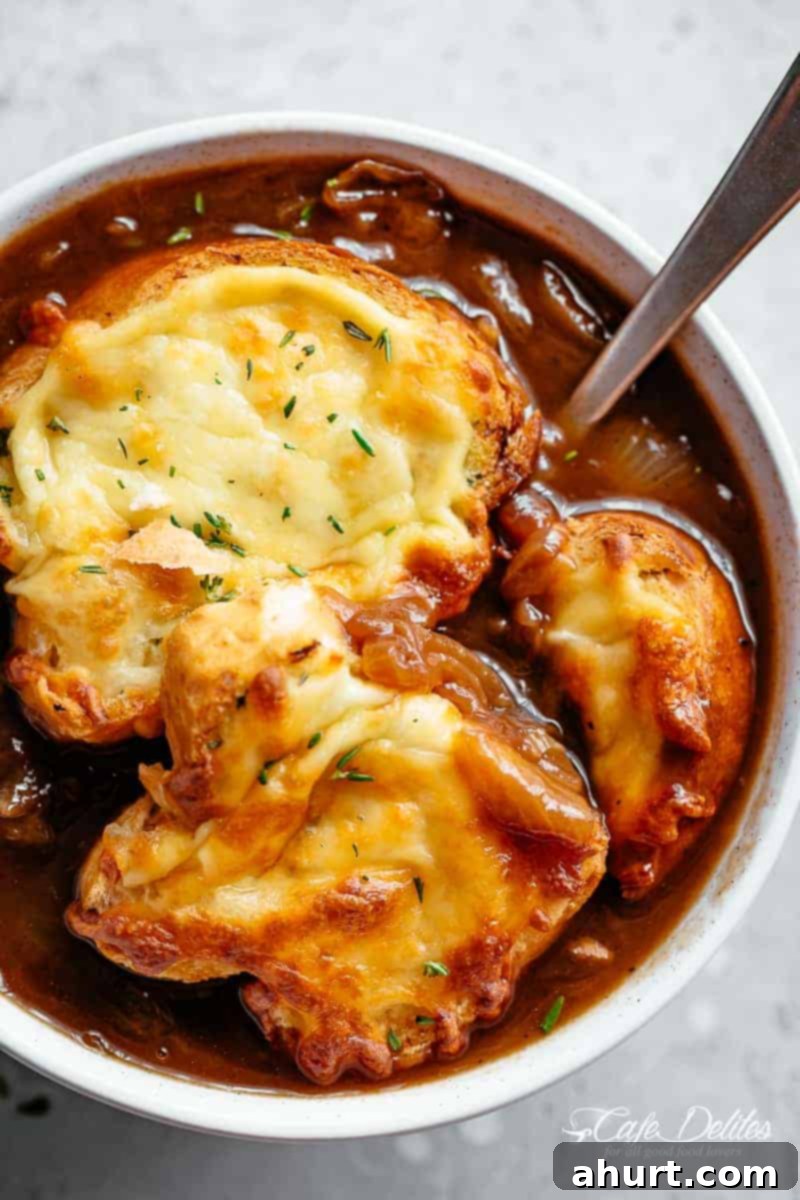Mastering Classic French Onion Soup: A Step-by-Step Guide to Rich, Caramelized Perfection
Classic French Onion Soup is undeniably one of the most delightful and comforting soups known worldwide. With its signature rich, golden-brown broth and an unparalleled depth of flavor, this dish promises an extraordinary culinary experience from the very first spoonful. It’s more than just a soup; it’s a warm embrace on a chilly day, a testament to the magic that simple ingredients can create with a little patience and care.
The secret to a truly exceptional French Onion Soup lies in the meticulous caramelization of the onions, which form the heart of a robust and intensely flavorful stock. This slow cooking process transforms humble onions into sweet, savory gems, imbuing the entire soup with an umami richness that sets it apart. Simmered to perfection with aromatic fresh herbs and the optional, yet highly recommended, splash of dry white wine, this soup culminates in a harmonious blend of flavors. Served traditionally with slices of golden Cheesy Garlic Bread, it’s a gourmet experience that is absolutely worth every precious moment you spend crafting it in your kitchen.
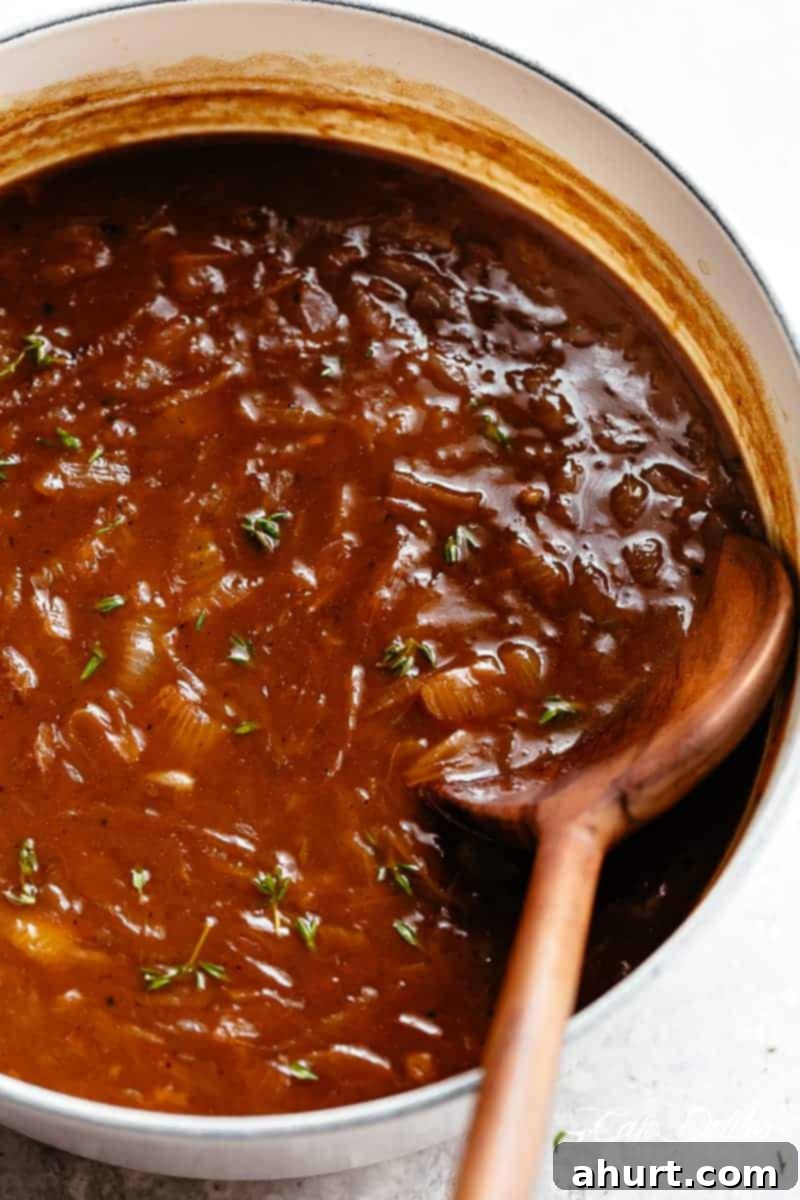
Unlocking the Secrets of French Onion Soup at Home
French Onion Soup holds a special place in the hearts of food lovers globally, celebrated for its complex flavors and satisfying warmth. However, its sophisticated reputation often leads many home cooks to feel intimidated by the idea of making it from scratch. Fear not! This comprehensive guide is designed to demystify the process, walking you through each step of this classic French onion soup recipe. Our goal is to empower you to create a restaurant-quality soup right in the comfort of your own kitchen, proving that this culinary masterpiece is entirely achievable for anyone.
Could there be anything more comforting on a blustery day than a steaming bowl of homemade soup? French Onion Soup offers a unique texture that is intentionally richer and slightly thicker than many other soups. This body is essential to complement the deep, sweet, and savory notes of the caramelized onions. The transformation of the onions is the cornerstone of this recipe: they are cooked low and slow for approximately 45 minutes, a process that patiently coaxes out their natural sugars and sweetness. This extended cooking time allows for the development of profound, almost meaty flavors, interwoven with subtle spices, culminating in an incomparable base for the soup. It’s this dedication to the caramelization that gives the soup its iconic depth and distinguishes it from any other.
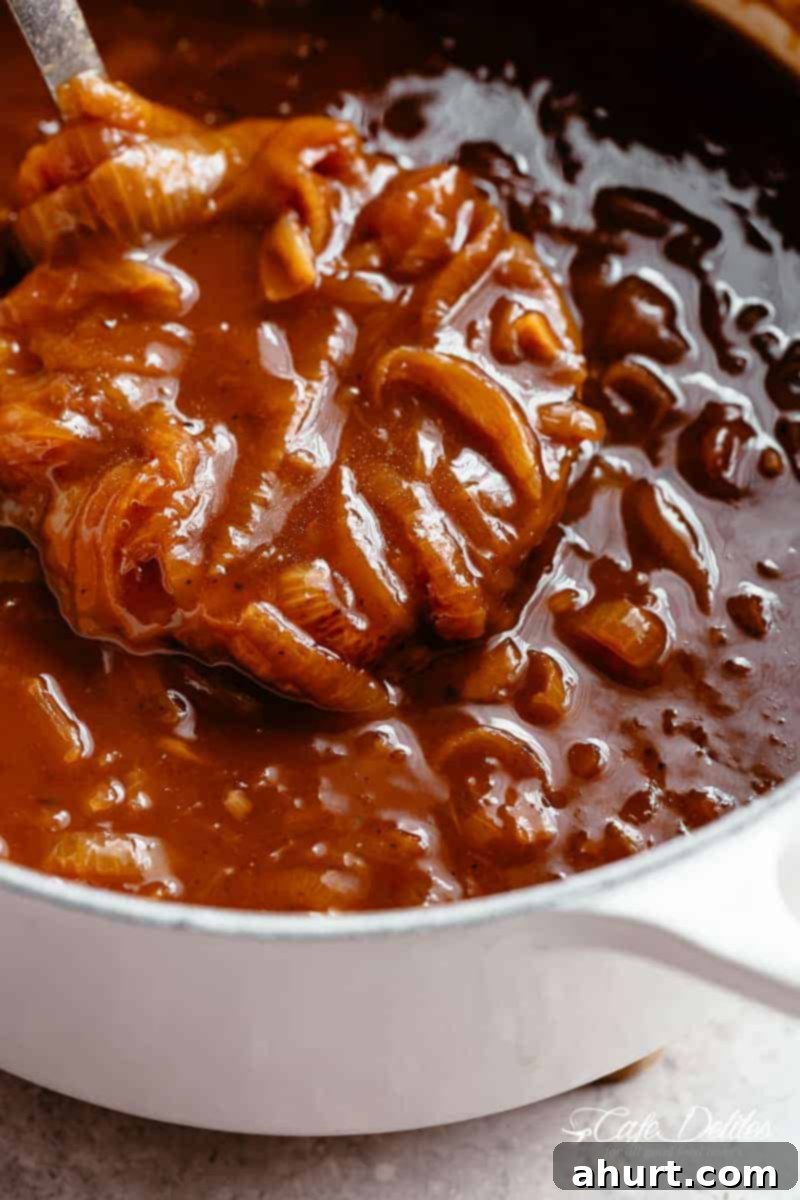
Essential Ingredients for Authentic French Onion Soup
Given the immense depth and richness of French Onion Soup’s flavor, you might naturally assume it requires a long list of exotic or complex ingredients. Surprisingly, this truly classic recipe relies on just a few core, high-quality components, proving that simplicity often yields the most profound results. Each ingredient plays a vital role in building the soup’s characteristic taste profile:
- Butter: Opt for a good quality unsalted butter. Butter is crucial for starting the caramelization process, adding richness, and preventing the onions from sticking.
- Olive Oil: Used in conjunction with butter, olive oil helps prevent the butter from burning at higher temperatures and adds another layer of subtle flavor.
- Onions: The undisputed star of the show! We’ll delve into the best type of onions shortly, but their slow cooking and caramelization are what give the soup its signature sweet and savory complexity.
- Flour: A small amount of all-purpose or plain flour is added to create a light roux. This acts as a thickener, giving the soup a slightly richer body and helping to bind the flavors together.
- Dry White Wine: This ingredient is key for deglazing the pot, a crucial step that involves scraping up all the flavorful browned bits (fond) from the bottom of the pan. This fond is packed with umami and greatly enhances the soup’s intensity. If you prefer to skip the wine, an equal amount of extra beef broth works as an excellent substitute.
- Beef Stock/Broth: The foundation of the soup’s liquid. A high-quality beef stock or broth is essential for achieving that deep, savory base. While beef is traditional, chicken broth can be used for a lighter flavor profile.
- Beef Bouillon Powder: This small addition acts as a flavor booster, intensifying the beefy notes and ensuring a robust broth.
- Fresh Herbs: Sprigs of fresh thyme and bay leaves are simmered with the soup, infusing it with their aromatic, earthy notes, which beautifully complement the sweet onions and rich broth.
- Garlic: Minced garlic adds a pungent, aromatic layer that enhances the overall savoriness of the soup.
- Salt and Pepper: Essential for seasoning and balancing all the flavors, adjusted to taste.
- Cheesy Garlic Bread: While a topping, it’s an integral part of the serving experience, adding texture, richness, and that irresistible cheesy pull.
Choosing the Best Onions for French Onion Soup
The type of onion you select can subtly influence the final flavor profile of your caramelized onions and, by extension, your French Onion Soup. Each variety offers a slightly different nuance:
- White Onion: These are generally sweet and mild when cooked, but can sometimes lack the deep, complex sweetness that caramelization brings out in other varieties.
- Red Onion: Offering a stronger, more pungent onion flavor, red onions tend to be slightly more bitter and don’t achieve the same level of sweetness as yellow onions when caramelized. They’re better suited for fresh applications or quick sautéing.
- Yellow Onion: This is our absolute favorite for French Onion Soup. Yellow onions possess a wonderfully mild flavor and, most importantly, a naturally high sugar content that is perfect for caramelization. When cooked slowly, they develop an incredible sweetness and deep amber color that is quintessential to the soup’s character.
When preparing your onions, cut them in half from top to bottom, then trim just a small portion of the root end – crucially, leave enough of the root intact to hold the onion together. Place the onion cut-side down on your cutting board and slice it thinly from the side. This technique ensures that the onion rings remain largely connected during slicing and the initial cooking phases, preventing them from completely falling apart into tiny pieces. This helps them cook more evenly and maintain a pleasant texture in the soup.
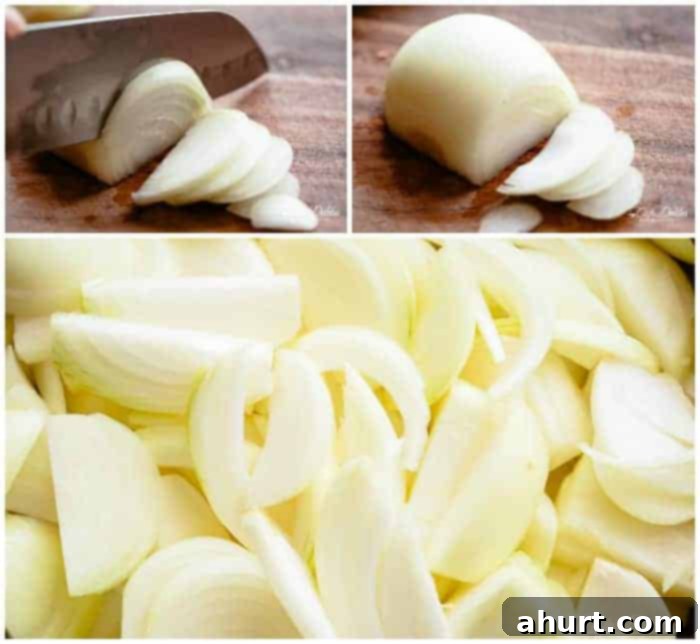
The Art of Making French Onion Soup: A Detailed Process
Crafting French Onion Soup is a labor of love, primarily centered around the art of caramelizing onions. This initial step is the most time-consuming but also the most critical for developing the soup’s signature depth of flavor. Patience is truly a virtue here, and cutting corners will compromise the final result.
First and foremost, the onions are cooked slowly until they achieve a rich, golden brown hue and a wonderfully tender, caramelized texture. You might be tempted to rush this process, merely sautéing them until they’re soft but not deeply colored. Please resist this urge! Allowing them to cook until they reach that deep, golden brown stage makes an indescribable difference in the flavor, transforming their sharp bite into a profound sweetness. This transformation is known as the Maillard reaction, a chemical process that creates complex flavors and aromas, making the onions truly exceptional.
The key to achieving perfectly caramelized onions lies in a technique of intermittent frying. Let the onions cook undisturbed for a good 5-8 minutes between stirs. During these periods, natural sugars in the onions will brown and stick to the bottom of your pot, forming a layer of “fond.” With each subsequent stir, you will scrape the bottom of the pan vigorously, incorporating these intensely flavorful browned bits back into the onions. This continuous cycle of browning and scraping ensures that all the rich, savory notes are distributed evenly, building layers of flavor as the onions slowly turn into sweet, melting perfection. This entire caramelization process typically takes around 30-45 minutes, but the rich, complex flavors it develops are absolutely worth the wait.
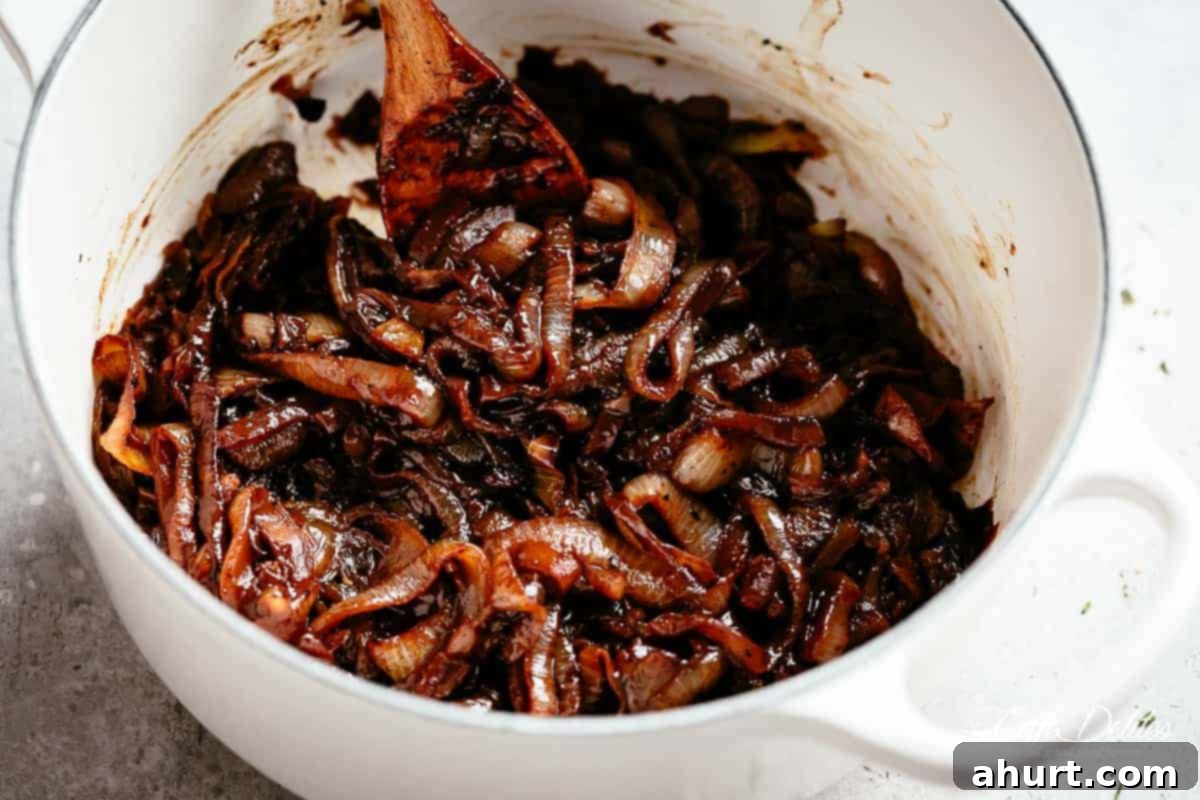
Once your onions are beautifully caramelized, the pot is then deglazed. This is where a touch of dry white wine (or extra beef broth, if you’re skipping the wine) comes into play. Pouring the liquid into the hot pot helps release all those magnificent browned bits of fond from the bottom, dissolving them into the liquid and enriching the soup base even further. After deglazing, flour is added and cooked briefly to create a roux, which will slightly thicken the soup. Finally, the beef stock, beef bouillon, and fresh herbs (thyme and bay leaves) are introduced. The soup is then brought to a boil, and subsequently reduced to a gentle simmer, allowing all the flavors to meld and deepen over the next 30-40 minutes. This simmering period ensures a harmonious blend of all ingredients, creating a truly robust and comforting broth.
Lastly, while your glorious soup is gently simmering, it’s the perfect time to prepare your cheesy garlic breads. These are an easier and equally delicious way to serve French Onion Soup without requiring individual oven-proof bowls for broiling. The cheesy bread acts as the perfect vehicle to soak up the rich broth and adds a delightful textural contrast, especially when topped with melted cheese.
Beyond Gruyère: Delicious Cheese Alternatives for French Onion Soup
While Gruyère is the traditional cheese of choice for French Onion Soup, its nutty and slightly sweet flavor profile is not the only option. Our recipe suggests a fantastic blend of mozzarella and parmesan cheese, which provides a satisfying melt and a tangy, savory counterpoint to the sweet onions. However, for those looking to experiment or use what’s on hand, several other cheeses work beautifully:
- Swiss Cheese: Similar to Gruyère, Swiss cheese offers a mild, nutty flavor and melts wonderfully, creating those classic long, gooey strands.
- Gouda: With its creamy texture and slightly sweet, caramel-like notes, Gouda melts into a smooth, luxurious topping that complements the soup’s richness.
- Provolone: A semi-hard Italian cheese, Provolone has a sharp, tangy flavor that provides a nice contrast to the sweet onions and delivers a fantastic melt.
- Brie: For a truly decadent experience, try a slice of rindless Brie. Its rich, buttery, and slightly earthy flavor, combined with its incredibly creamy melt, adds an element of gourmet luxury to each spoonful.
Experimenting with different cheeses allows you to customize the soup to your preference, ensuring that cheesy, golden topping is always a highlight.
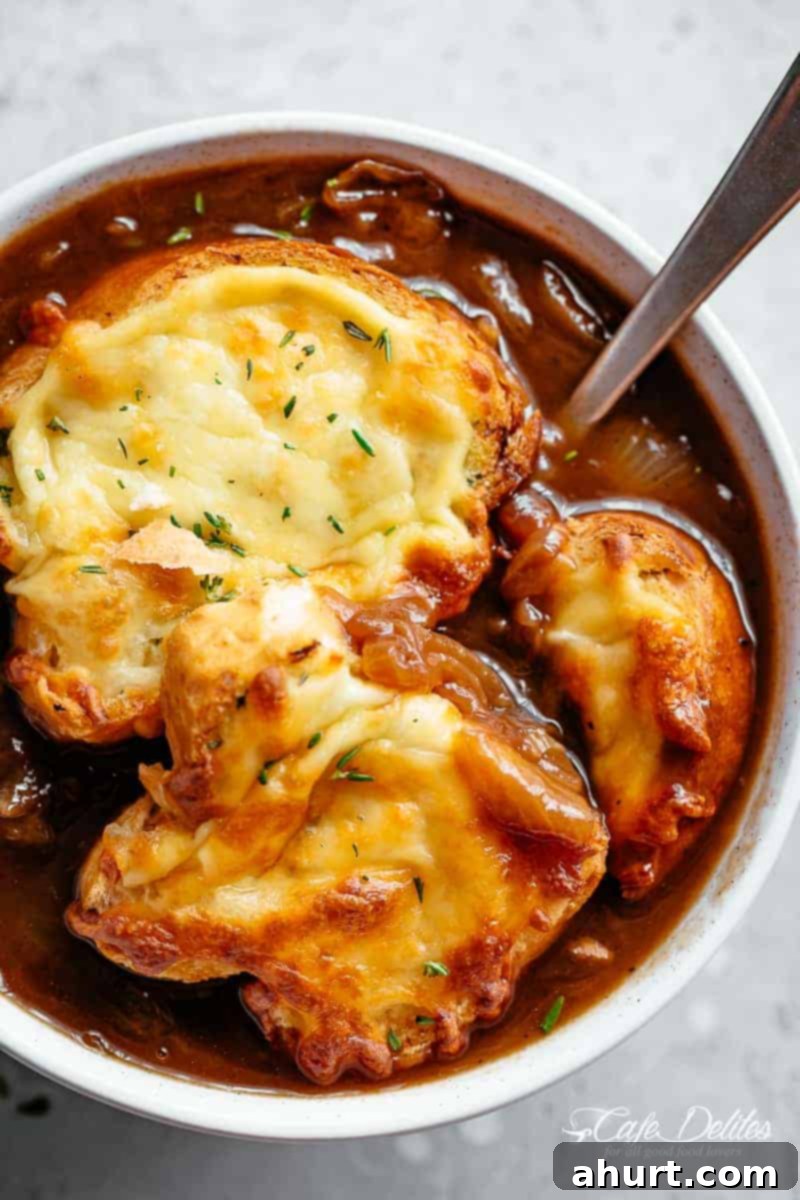
Choosing the Best Wine for French Onion Soup (and Substitutes)
Incorporating wine into French Onion Soup, particularly during the deglazing step, adds a layer of acidity and complex flavors that truly elevate the broth. The general rule of thumb when cooking with wine is, “if you can’t drink it, don’t cook with it.” This ensures you’re using a quality product that will enhance, not detract from, your dish.
I highly recommend using a dry white or red wine. Dry wines have less residual sugar, meaning they won’t make your soup overly sweet. They also provide the necessary acidity to cut through the richness and lift the flavors. Excellent choices include:
- Dry White Wines: Pinot Grigio/Gris, Sauvignon Blanc, Sémillon, or an unoaked Chardonnay. These provide crisp acidity and often subtle fruity notes that complement the onions.
- Dry Red Wines: Merlot or Pinot Noir. While less common, a dry red can add a deeper, more robust, and earthy flavor to your soup, creating a rich, darker broth.
What Can I Use Instead of Wine in French Onion Soup?
If you prefer to avoid alcohol or simply don’t have wine on hand, a perfect substitute is readily available. You can easily replace the wine with an equal amount of extra beef stock or broth. This ensures the deglazing process still occurs, capturing all those precious browned bits, and maintains the savory depth of the soup without introducing alcohol.
Explore More Delicious Soup Recipes
If you’ve enjoyed mastering this classic, delve into our collection of other comforting and flavorful soup recipes:
Vegetable Soup
Cauliflower Soup
Cream of Mushroom Soup
Creamy Roasted Tomato Basil Soup (No Cream)
Slow Cooker Creamy Tortellini Soup
Creamy Ham Potato Soup
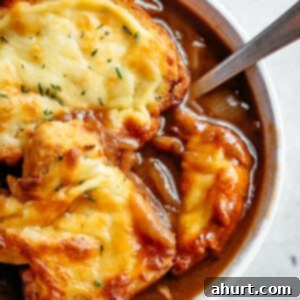
Pin
French Onion Soup
Ingredients
- 4 tablespoons unsalted butter
- 2 tablespoons olive oil
- 6 large yellow onions peeled, halved and thinly sliced
- 1 tablespoon garlic minced, or 4 cloves garlic, minced
- 1/4 cup flour, plain or all purpose
- 1/2 cup dry white wine or red wine
- 2 sprigs fresh thyme roughly chopped
- 6 cups beef stock
- 1 teaspoon beef bouillon powder
- 2 whole bay leaves dried or fresh
- 1 pinch salt to taste
- 1 pinch pepper
- 1 batch cheesy garlic bread
Instructions
-
In a large pot or Dutch oven over medium-low heat, gently heat the olive oil and melt the unsalted butter. Add the thinly sliced yellow onions and stir them well to ensure they are evenly coated with the oil and butter. Cover the pot and allow the onions to cook for 20 minutes, stirring thoroughly every five minutes or so, until they have softened considerably.
-
Increase the heat to medium-high and add 1/2 teaspoon of salt. Continue to stir and cook the onions for another 15 minutes, or until they turn a deep golden brown, becoming wonderfully soft and richly caramelized. During this stage, the bottom of the pan will accumulate browned bits (fond) – this is where an immense amount of flavor is concentrated, so do not skip this step!
-
Stir in the minced garlic and cook for just one minute until fragrant. Next, sprinkle in the flour and cook, stirring constantly, for about 4 minutes to lightly brown it and create a roux. Pour in the wine to deglaze the pan, using a wooden spoon to scrape up all the flavorful browned bits stuck on the bottom. Add the fresh thyme sprigs and simmer the wine for 2 minutes, allowing it to reduce by half.
-
Add the beef stock, beef bouillon powder, and bay leaves; bring the mixture to a boil. Once boiling, reduce the heat to low and gently simmer the soup, partially covered with a lid, for 30-40 minutes. This allows all the flavors to meld and deepen.
-
While the soup is simmering, take this time to prepare 1 loaf of cheesy garlic bread, or opt for individually portioned garlic breads, as desired.
-
To serve this incredible soup, first taste test and season with a little extra salt and pepper, adjusting to your preference. Ladle the hot soup into individual bowls and generously top each serving with 1 or 2 slices of your prepared cheesy toast. Enjoy the rich flavors!
Notes
BEST WINE IN SOUP
Wine is optional but highly recommended to deglaze the pan and infuse the soup with an added layer of flavor and acidity. For the best results, I recommend using a dry white or red wine, such as a good quality Pinot Grigio/Gris, Sauvignon Blanc, Sémillon, Chardonnay, Merlot, or Pinot Noir. A good rule of thumb is: if you wouldn’t drink it, don’t cook with it.
WHAT CAN I USE INSTEAD OF WINE IN FRENCH ONION SOUP?
If you prefer to omit wine, simply replace it with an equal amount of extra beef broth or stock. This will still allow you to deglaze the pan and capture all the delicious fond, maintaining the savory depth of your soup.
Nutrition
Nutrition information is automatically calculated, so should only be used as an approximation.
